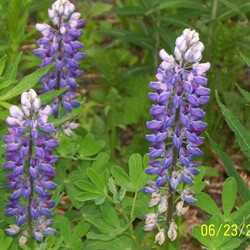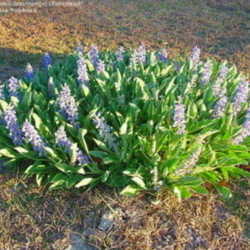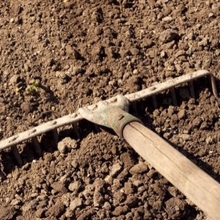Lupines, or lupins, are a large family of plants, encompassing over 200 species of wildflowers native to North America. They are in the pea family (Leguminosae or Fabaceae), and include both annual and short-lived perennial varieties. Like other members of the pea family, they improve the soil they are grown in by adding nitrogen. They prefer full sun and well-drained, sandy soil, though they grow in wide variety of climates. Though difficult to divide, due to their long taproot and tendency to resent transplanting, they are easy to grow from seed, and will often self-seed. This habit somewhat makes up for their relatively short life-span.
Lupine seeds found their way to Great Britain in the 1820's, where the willowy spikes of blue and purple became popular additions to cottage-style gardens. Nearly a hundred years later, however, one man took an interest in the humble wildflower that would change how we saw lupines forever. This is the story of the Russell lupine.
 Our story begins with George Russell. Mr. Russell was born in 1857, and spent his early adult years working as a nurseryman. In his early 50's, George left his position with a nursery, and began doing gardening work independently in order to give him more flexibility to care for his ailing wife. After his wife passed away, he and a neighbor, Mrs. Heard, formed a sort of partnership. Mrs. Heard's son, Arthur, wasn't in the best of health, and at that time, doctors had the wisdom to prescribe fresh air, rather than pills. Mrs. Heard agreed to help Mr. Russell with light housework, if in exchange, he would take her son, Arthur, with him on his gardening jobs, to help provide him with exercise and fresh air.
Our story begins with George Russell. Mr. Russell was born in 1857, and spent his early adult years working as a nurseryman. In his early 50's, George left his position with a nursery, and began doing gardening work independently in order to give him more flexibility to care for his ailing wife. After his wife passed away, he and a neighbor, Mrs. Heard, formed a sort of partnership. Mrs. Heard's son, Arthur, wasn't in the best of health, and at that time, doctors had the wisdom to prescribe fresh air, rather than pills. Mrs. Heard agreed to help Mr. Russell with light housework, if in exchange, he would take her son, Arthur, with him on his gardening jobs, to help provide him with exercise and fresh air.
It was in 1911, while at one of these independent jobs, that Mr. Russell was struck by the idea that would change how gardeners everywhere experienced the humble lupine. At age 54, Mr. Russell saw lupines in a cut flower arrangement in a vase at the home of his employer, Mrs. Micklethwaite. He later told the story of how he said to himself, "Now, there's a plant that could stand some improving." Little did he know, that moment was the beginning of more than 30 years of deliberate, careful effort to do just that. Mr. Russell had found his life's work.
 Mr. Russell had two allotments, on which he originally grew some vegetables and flowers. He dedicated them both to his project, and planted several different varieties of lupines, including L. polyphyllus or L. arboreus, among others. Mr. Russell claimed that he never hand-pollinated or intentionally crossed any specific varieties, leaving that work to the bees. He did, however, have some specific goals in mind. He wanted a tightly packed flower form, with no stem showing between the rows of blooms, and he wanted to select for colors other than the usual blues and purples common in the wildflower forms. Mr. Russell would frequently fill his allotments with 5,000 lupine plants each year, and then cull all but the best 250 or so plants that displayed the characteristics he wanted. He would save seed from only those plants, and begin again the following year.
Mr. Russell had two allotments, on which he originally grew some vegetables and flowers. He dedicated them both to his project, and planted several different varieties of lupines, including L. polyphyllus or L. arboreus, among others. Mr. Russell claimed that he never hand-pollinated or intentionally crossed any specific varieties, leaving that work to the bees. He did, however, have some specific goals in mind. He wanted a tightly packed flower form, with no stem showing between the rows of blooms, and he wanted to select for colors other than the usual blues and purples common in the wildflower forms. Mr. Russell would frequently fill his allotments with 5,000 lupine plants each year, and then cull all but the best 250 or so plants that displayed the characteristics he wanted. He would save seed from only those plants, and begin again the following year.
His young protege, Arthur Heard, continued to assist Mr. Russell as he continued this work for over 20 years. The results were astounding! The plants Mr. Russell developed bore only a passing familial similarity to the loose, purple blooms of the wild forms of lupine. He developed reds, corals, yellows, and pinks, among a rainbow of other colors, and even forms that alternated two colors, or a single color and white, along the inverted cone of the bloom stalk.
 For 23 years, Mr. Russell refused all offers to buy his stock or sell his plants. He questioned whether anyone else would continue to his exacting specifications, and refused to give up control over the plants that bore his name, much to the frustration of the nursery trade. In 1935, a nurseryman named James Baker finally persuaded the 78-year-old Russell to relent, with the promise that if he moved his nursery stock to Baker's fields near Wolverhampton, he would provide housing on-site for both Russell, and his assistant, Arthur Heard (who now had a wife of his own), where Russell would continue to maintain personal control over his plants. Mr. Russell continued breeding the plants to his exacting standards, and Mr. Baker introduced the first of his lupines to the gardening world.
For 23 years, Mr. Russell refused all offers to buy his stock or sell his plants. He questioned whether anyone else would continue to his exacting specifications, and refused to give up control over the plants that bore his name, much to the frustration of the nursery trade. In 1935, a nurseryman named James Baker finally persuaded the 78-year-old Russell to relent, with the promise that if he moved his nursery stock to Baker's fields near Wolverhampton, he would provide housing on-site for both Russell, and his assistant, Arthur Heard (who now had a wife of his own), where Russell would continue to maintain personal control over his plants. Mr. Russell continued breeding the plants to his exacting standards, and Mr. Baker introduced the first of his lupines to the gardening world.
In 1937, Mr. Russell finally displayed his work at a Royal Horticulture Society flower show, and his stunning lupine display took the gardening world by storm! His display won a gold medal, and the demand for Russell lupines was immediate and long-lasting. Over time, George Russell was named a Member of the Most Excellent Order of the British Empire (MBE), and also received a Veitch Memorial Medal for a lifetime's achievement in horticulture from the Royal Horticultural Society.
 Sadly, with Mr. Russell's eventual death at age 94, and the post-war changes in the field of horticulture, there was no one to continue the careful breeding and selection that produced such stunning and various colors and forms. Rather than continue to propagate the lupines by vegetative cuttings, and diligently cull those that reverted back to the weedier traits of their wildflower ancestors, the lupines were left to self-seed. Many were victims of newly introduced diseases, such as cucumber mosaic virus, and insect pests, specifically the American lupine aphid. With no one to carefully oversee their survival and propogation, most of the original Russell hybrids have been lost.
Sadly, with Mr. Russell's eventual death at age 94, and the post-war changes in the field of horticulture, there was no one to continue the careful breeding and selection that produced such stunning and various colors and forms. Rather than continue to propagate the lupines by vegetative cuttings, and diligently cull those that reverted back to the weedier traits of their wildflower ancestors, the lupines were left to self-seed. Many were victims of newly introduced diseases, such as cucumber mosaic virus, and insect pests, specifically the American lupine aphid. With no one to carefully oversee their survival and propogation, most of the original Russell hybrids have been lost.
Pat and Michael Edwards, under the direction of Russell's former assistant, Arthur Heard, took up the baton nearly three decades later. Through painstaking research, Pat Edwards has identified records of up to 152 distinct colors and varieties of Russell lupines once offered through seed catalogs, ranging from pale yellows and golds, through pinks, corals, reds, intense violets, and many bi-colored varieties. The vast majority of these lovely varieties have been lost, however. The Edwardses have managed to restore only roughly a dozen of the original varieties from seeds found on the defunct grounds of the former Baker nursery.
Several other breeders have also taken up the cause of the lupine. Johnny Walker, a former policeman who admired Russell's fields of lupines, established his own bed of lupines from original Russell seed, and passed on the legacy by sharing seed with Sarah Conibear, now with Westcountry Lupins. With their renewed popularity, new series are being released, and lupines are once again making an impressive showing at flower shows. Conibear's display at the 2014 Chelsea Flower Show has drawn the attention of the gardening world to this unique plant, especially with her new red introduction, the Beefeater, named for the famously red-clad guards at the Tower of London. Maurice and Brian Woodfield have also made great strides in developing new strains of lupines, specializing in bicolors and vivid hues. They have won 10 gold medals at the Chelsea Flower Shows with their lupines, and are determined not to allow them to fall into decline again.
We owe so much to George Russell, for having the vision to see what the humble wildflower form of the lupine could become.
 |
 |
Photo Credits:
In order of appearance. Many thanks to the photographers who make their work available through such resources as Flickr Creative Commons, and Wikimedia Commons! Pictures have been used in accordance with the terms of usage of those respective sites. Click on the links in photo credits to see the original image.
Thumbnail image of blue and white lupine: Flickr Creative Commons, submitted by photographer Rosana Prada, some rights reserved.
Wild lavender blue lupine: Flickr Creative Commons, submitted by photographer Phillip Bouchard, some rights reserved.
Pink and yellow lupine with bee: Wikimedia Commons, submitted by Moritz Darge, some rights reserved.
Orange and yellow lupine: Flickr Creative Commons, submitted by photographer Evelyn Berg, some rights reserved.
Hot pink lupine: Wikimedia Commons, submitted by David McConeghy, some rights reserved.
Water droplets on lupine leaves: Flickr Creative Commons, submitted by photographer Logan Ingalls, some rights reserved.
Wild lupines at lakeside: Flickr Creative Commons, submitted by photographer ewoerlen, some rights reserved.
References:
Bourne, Val. "How to Grow Lupins," Saga. Retrieved from http://www.saga.co.uk/lifestyle/gardening/plant-portrait/lupins.aspx
Bourne, Val. "Lupins Rising Again with Rocket Power," Oxford Times, June 5, 2014. Retrieved from http://www.oxfordtimes.co.uk/leisure/outdoor/11258589.Luping_rising_again_with_rocket_power/
Dusoir, Rory. "Return of the Russell Lupines," Horticulture, May 1, 2007. Retrieved from http://www.hortmag.com/archive/return_of_the_russell_lupines
Whitsey, Fred. "Simply loopy: Fred Whitsey on the rise and fall of the lupin," The Telegraph, June 24, 2000. Retrieved from http://www.telegraph.co.uk/gardening/4791536/Simply-loopy.html
















